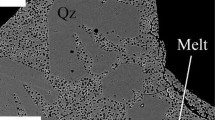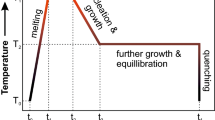Abstract
Impurity inhomogeneities and other structural defects have been studied by means of transmission electron microscopy (TEM), X-ray microanalysis and electron paramagnetic resonance (EPR) in untreated and heat-treated quartz samples of three genetic types: hydrothermal, pegmatitic and magmatic. The impurities present are Al, Na and H2O, which occupy tetrahedral (Al3+) or interstitial (Na+, H2O) positions in the quartz lattice.
Impurities form imperfections of various degrees of segregation: from point defects to micropores with a gas-liquid content. Their size, form, density and distribution in the lattice depend on the formation conditions of the quartz, the presence of dislocations and plane defects serving as sinks for the impurity atoms, and the heat treatment regime. Experimental data indicate that gas-liquid inclusions of dimensions up to some microns are the result of impurity segregation during postcrystallizational cooling.
Crystalline quartz amorphizes upon electron irradiation. A model of structural water explaining experimentally observed features of this phenomenon is proposed whereby the water molecule, represented as a dipole, enters microregions of the silica lattice with a high impurity content and there forms a bond between ‘defective’ [SiO3]2− and [AlO4]5− tetrahedra. On irradiation, the Si---O donor-acceptor bonds trap nonelastically scattered electrons and are ruptured as a result. The water released by this lattice discontinuity forms microbubbles that diffuse along sinks into the larger micropores thus further increasing their volume.
Similar content being viewed by others
References
Ardell AI, Christie JM, McCormick JW (1974) Dislocation images in Quartz and the determination of burgers vectors. Philos Mag 29:1399–1411
Ayensu A, Ashbee KHG (1977) The creep of quartz single crystals, with special reference to the mechanism by which water accommodates dislocation glide. Philos Mag 36:713–723
Baker C (1970) The effect of heat-treatment and nitrogen addition on the critical current density of a worked Niobium, 44 wt% Titanium superconducting alloy. J Mater Sci 5:40–52
Balakirev VG, Kievlenko EYa, Nikolskaya LV, Samoilovitch MI, Hadzhi VE, Tsinober LI (1979) Mineralogy and Crystallophysics of the gem varieties of silica, pp 148, Moscow: Nedra (in Russian)
Bazarov LSh, Stenina NG (1978) The influence of heat-treatment on the defect structure of natural quartz. Dokl Akad Nauk USSR 243:1261–1264 (in Russian)
Belov NV (1981) About two perfect liquids. Physico-chemical mechanics and lyophilycy of dispersive systems. Kiev: Naukova Dumka, Issur 13:5–8 (in Russian)
Bernal JD, Fowler RH (1933) A theory of water and ionic solution, with particular reference to hydrogen and hydroxyl ions. J Chem Phys 1:515–548
Electron microscopy in mineralogy (1976) (ed H-R Wenk et al) Berlin-Heidelberg-New-York: Springer
Fyfe WS, Price NJ, Thompson AB (1978) Fluids in the Earth's crust. Amsterdam-Oxford-New-York: Elsevier-Scientific Publishing Company
Heydenreich J (1969) Transmission Electron microscopic investigations of thin monocrystalline alkali halide foils. Roumaine de Physique 14:1253–1265
Hirsch PB, Howie A, Nicholson RB, Pashley DOW, Whelan MJ (1968) Electron microscopy of thin crystals. Mir Moscow (in Russian)
Mackey IH (1963) ESR study of impurity-related color centers in Germanium doped quartz. J Chem Phys 33:74–83
McLaren AC, Phakey PP (1965) A transmission electron microscope study of amethyst and citrine. Austral J Phys 18:135–141
McLaren AC, Phakey PP (1966) Transmission electron microscope study of bubbles and dislocations in amethyst and citrine quartz. Aust J Phys 19:19–24
McLaren AC, Retchford JA (1969) Transmission electron microscope study of the dislocations in plastically deformed synthetic quartz. Phys Status Solidi 33:657–660
McLaren AC, Retchford JA, Criggs DT, Christie JM (1967) Transmission electron microscope study of brazil twins and dislocations experimentally produced in natural quartz. Phys Status Solidi 19:631–644
Montheillet F, Houdin JM, Frade G (1973) Étudeen microscopie electronique du contraste des dislocations décorées dans des structures cubiques. Phys Status Solidi 17:593–607
Physical investigation of quartz (Ed Samoiylovitch MI, Khetchikov LN) pp 89. Moscow: Nedra 1975 (in Russian)
Rinneberg H, Weil YA (1972) ESR studies of Ti3+-H+ centers in X-irradiated α-quartz. J Chem Phys 56:2019–2028
Schnadt R, Schneider J (1970) The electronic structure of the trapped-hole center in smoky quartz. Phys Kondens Mater 11:19–42
Schnadt R, Räuber A (1970) Motional effects in the trapped-hole center. Solid State Commun 9:159–161
Silsbee RH (1961) Electron spin resonance in neutron-irradiated quartz. J Appl Phys 32:1459–1468
Stenina NG, Titov AT (1979) Preparation of mono-heterophase mineral samples for examination with transmission electron microscopy. Geol and Geophys 6:124–130
Wecks RA (1963) Paramagnetic resonance of centres in crystalline quartz. Phys Rev 130:570–576
Weil IA (1971) Germanium-hydrogen lithium center in α-quartz. J Chem Phys 55:4605–4690
White S, Treagus JE (1975) The effects of polyphase deformation on the intracrystalline defect structures of quartz. Neues Jahrb Mineral, Ab 123:219–236
Author information
Authors and Affiliations
Rights and permissions
About this article
Cite this article
Stenina, N.G., Bazarov, L., Shcherbakova, M. et al. Structural state and differusion of impurities in natural quartz of different genesis. Phys Chem Minerals 10, 180–186 (1984). https://doi.org/10.1007/BF00311475
Received:
Issue Date:
DOI: https://doi.org/10.1007/BF00311475




